Everything you need to know about wooden skirting boards
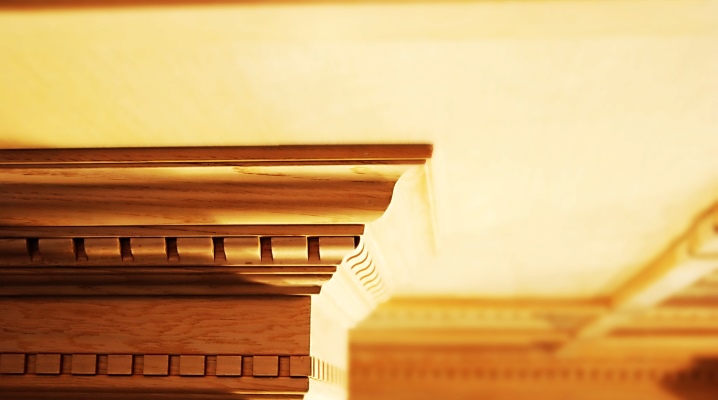
Wooden skirting boards are now rarely used in ceilings when it comes to ordinary apartments. The exception is baths, saunas and interiors with the use of natural materials.
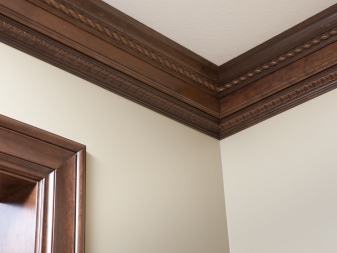
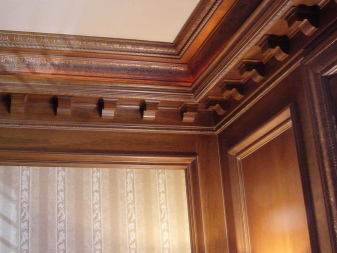
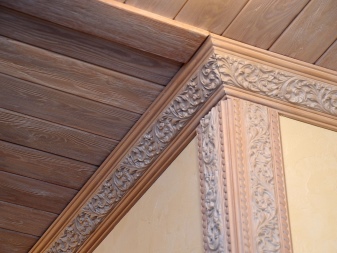
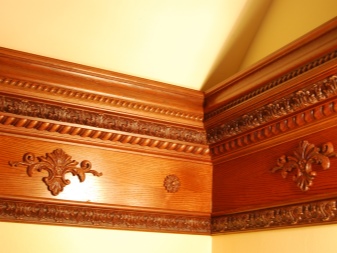
Peculiarities
In addition to the decorative function, the use of decor along the perimeter of the walls helps to visually raise the ceiling, correct minor flaws in the layout.
Also, the use of skirting boards gives the interior a complete and harmonious look.
It is not for nothing that the ceilings in old houses were decorated with wide plaster borders. Today on sale you can find ceiling plinths made of polyurethane, PVC. Each of them has its own pros and cons.
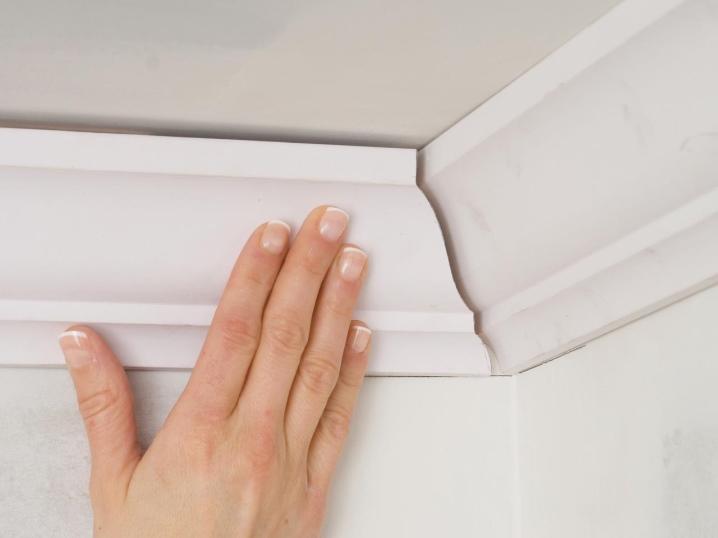
The advantages of wood finishing materials.
- Environmental friendliness. Natural materials do not emit harmful substances, do not cause allergies.
- Large selection of products - from simple strips to carved wide fillets.
- Durability - high-quality skirting boards will serve for more than a dozen years without losing technical and aesthetic characteristics.
- Aesthetics - wooden trim elements look great thanks to the unique wood pattern, give comfort.
- Versatility - moldings can be repainted, for example, to match the color of the walls or wallpaper pattern.

In addition to the advantages, the products also have disadvantages that should also be considered when choosing finishing materials.
- Demanding humidity... The wood “picks up water”, swells, and when it dries, it can change its shape and crack.
- The cost is much higher than that of analogs made of artificial materials. On average, one wooden profile will cost 400 rubles. For comparison, a foam plinth is 70-90 rubles.
- Rotting and fungal tendency - wood treatment with antiseptics will help to solve the problem.
- Careful installation required - any flaws in the base, improper fit or poorly processed seams will be very noticeable.
- The weight. PVC decor is lightweight, so it can even be installed on suspended ceilings. Wood moldings, especially those made from dense woods such as oak, are quite heavy. This point should be considered when buying.
- Complexity during installation, namely, corner fit.
- Rigidity - wood skirting boards cannot be bent, therefore semi-circular products are made only to order.
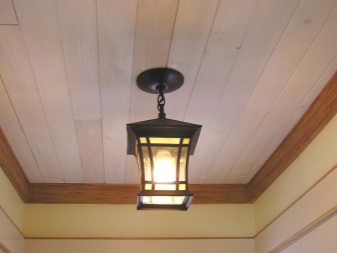
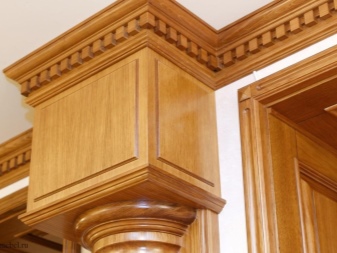
Wood is a combustible material, therefore, when making decorative skirting boards with your own hands, processing with fire retardants (compositions to increase fire resistance) is required.
To protect against moisture and extend the service life, special impregnations, varnish or wax are used.
When using waxes you can achieve the effect of both glossy and velvety surfaces.
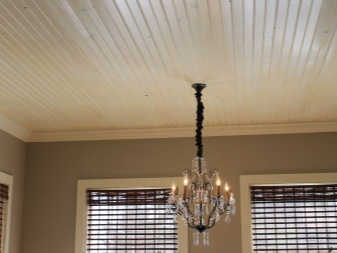
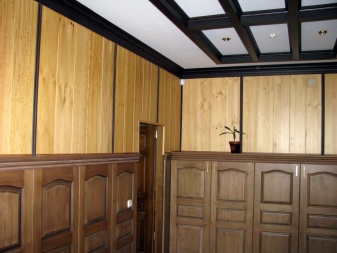
Species overview
Wooden skirting boards can be divided into several types, each of which is selected in accordance with the design and purpose of the room. For example, narrow curbs are suitable for an ordinary apartment with low ceilings, and wide cornices for a private house. Depending on the width, skirting boards can be divided into:
- curbs - narrow stripes with a simple decoration in the form of a curly edge, up to 50 mm wide;
- cornices - massive and wide, often decorated with carvings, used in the decoration of premises with high ceilings;
- fillets - suitable for decorating rooms in a classic style, distinguished by a sophisticated design;
- baguettes - the most common, differ in a variety of shapes and sizes.
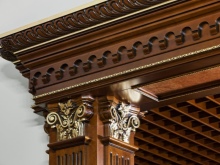
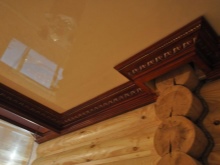
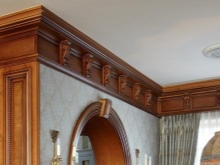
Important: wooden skirting boards should not be attached to false ceilings.Fillets made of wood are quite heavy, so it is better to choose PVC products.
How to choose?
The main criterion for choosing is the quality of wood, cost and resistance to high humidity conditions (if you choose skirting boards for the kitchen, bathroom, bath). For the manufacture of decor on the ceiling, conifers are most often used:
- spruce - resistant to moisture, but too hard;
- larch - not afraid of dampness, almost not subject to rotting, but at a cost much higher than other conifers;
- Pine - inexpensive material with good technical characteristics, easy to process;
- oak - is characterized by high strength, unique wood pattern, finishing elements are made mainly to order due to the high cost of the material.
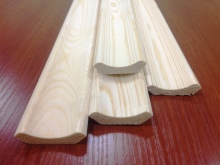
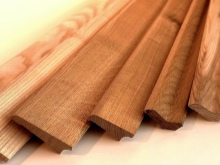

Conifers - inexpensive in price, thanks to light wood, they are perfectly amenable to staining and varnishing... Among the shortcomings, one can note the presence of resin passages (especially pine), which reduces resistance to dampness.
You can also buy skirting boards from inexpensive conifers covered with fine wood veneer in stores.
They are more expensive in price, but you can choose the decor "oak", "walnut", depending on the interior solution.
When choosing, pay attention to the quality of the wood - it must be dry. Ideally, there should be no knots or irregularities on the surface - you will have to spend time on additional processing. It is better to choose factory products - they are stronger, moreover, they are impregnated with special compounds that extend the life of the wood.
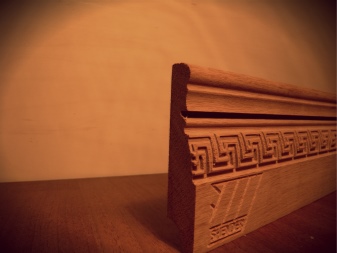
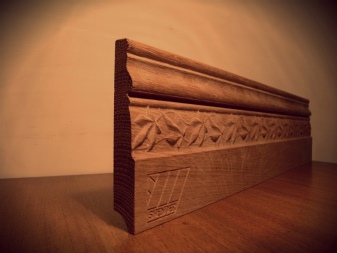
Wood products of natural moisture, when dried, can change their linear shape, deform, crack. You can make a plinth for a lining with your own hands, but you cannot do without a special tool. As for the width, one rule works here - the higher the ceilings, the wider the skirting board should be.
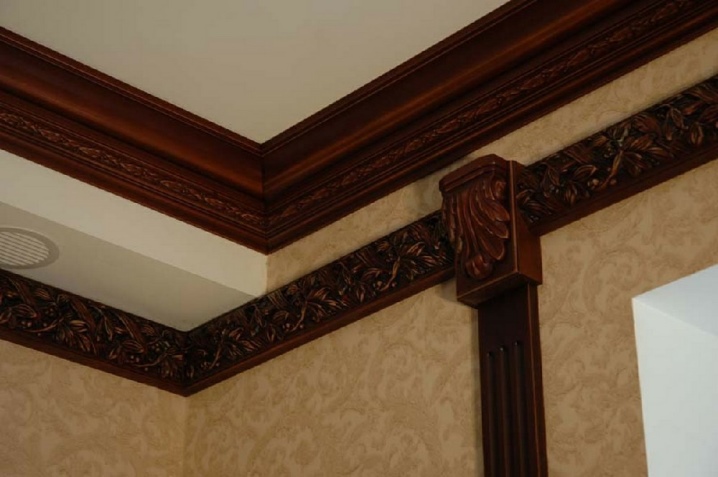
Installation rules
First you need to prepare the surface. The ceiling and walls are leveled and primed if necessary. The horizontal is checked using a building level or rule. Small irregularities (dents) and cracks can be covered with a putty, protruding parts (bumps, sagging) can be sanded. Check the corners (along the walls) and, if possible, level up to 90 degrees. You can check with a simple square.
Important: wooden fillets, unlike PVC skirting boards, do not bend, so it will not be possible to "pull" them to an uneven base.

It is better to buy skirting boards with a margin (15-20%) for sawing, adjusting to size and possible damage (for example, a narrow skirting board may crack, incorrect cutting is possible, etc.)... It is easier to calculate the amount of material if you draw in advance the layout of the fillets, taking into account niches, protrusions, and other features of the room - there will be less scraps.
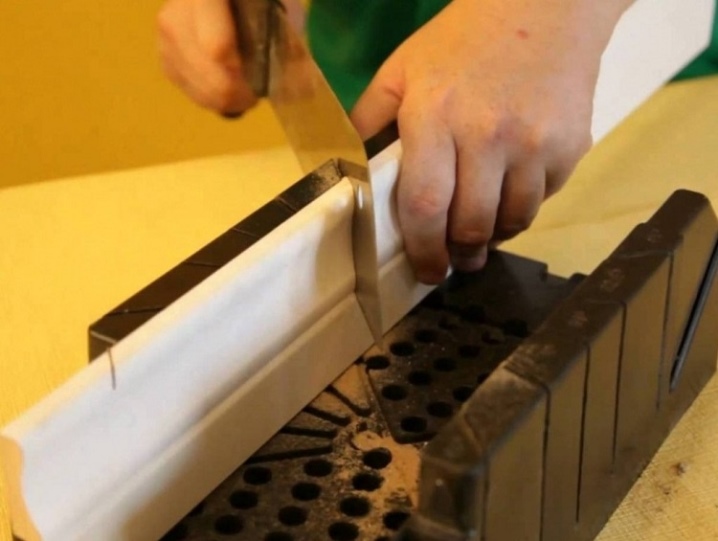
Preparation of fillets goes like this.
- The surface of the products is polished, eliminate roughness and unevenness with sandpaper (the number depends on the surface condition) or a brush attachment for a drill. Grinding is carried out in the direction of the fibers, after which the surface is moistened with water to raise the pile. In this way, streaks and irregularities can be avoided during subsequent painting.
- If you plan to use varnish, then pre-wood treated with a special primer.
- In order to emphasize the texture of the tree or give it a noble color, use an alcohol-based or water-based stain.
- It is better to choose an odorless, water-based paint. For a dense coating, you will need 2-3 layers. Before painting, the plinth is primed.
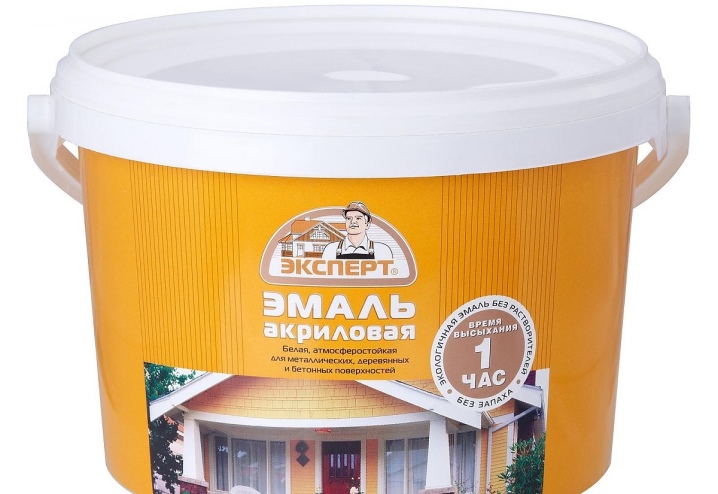
Installation steps, how to install.
- Markup - make marks with a simple pencil on the ceiling and along the lower edge of the skirting board. After "beat off" parallel lines along the markings using a stretched rope or the same plinth.
- Cut into fillets in size.
- Installation starts from the corners, after they go to straight sections.
- For joining skirting boards at the corners, the planks are cut at 45 degrees using a miter box.If it is impossible to achieve perfect right angles along the walls, unnecessary trimming of the board is used to fit the products, on which the desired angle is marked. After that, the board and the baseboard are clamped with a clamp and a simultaneous cut is made.
- If necessary details customized to size with a file, it is very important to file them correctly.
- Narrow skirting boards can glue, without the use of self-tapping screws or nail on small nails.
- Carved cornices (more than 100 mm wide) are too heavy, therefore, triangular bars are pre-mounted on the wall. The pitch is 0.45-0.5 m, depending on the weight of the fillets. This will help prevent deformation of the wooden parts when the humidity in the room changes.
- The skirting boards are attached to the skirting boards with self-tapping screws or nails without hats... In the first case, it is better to "drown" the screw head a little by pre-drilling a hole in diameter slightly larger than the screw head. And after installation, cover the attachment points with putty.
- If further repairs are planned, then, in order to avoid getting paint or wallpaper glue on the baseboard, masking tape is used.

Wood is a beautiful, eco-friendly, but capricious material. That's why before making a choice in favor of wood, it is worth weighing in advance all the pros and cons.
For information on how to properly join the skirting boards, see below.













The comment was sent successfully.